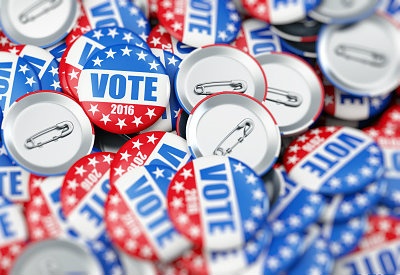 With so many communication channels at our disposal, and an unprecedented degree of social connectedness, political elections have become intensely competitive and downright overwhelming.
With so many communication channels at our disposal, and an unprecedented degree of social connectedness, political elections have become intensely competitive and downright overwhelming.
To defuse the situation, we voters have mastered the art of deflection. We toss direct mailers out as junk, hang up on telemarketers mid-sentence, quickly change the channel during TV spots and scroll past Facebook ads at blinding speed.
But one channel still holds promise: email marketing. Email is the fastest, most cost-effective way to reach a wide audience. More importantly, it’s non-invasive. Instead of being force-fed politics, voters have the choice to open and read email messages at a time that’s convenient for us-something we certainly appreciate.
If political marketing teams can overcome the rigors of modern-day elections with email campaigns, we should all be taking notes. In the spirit of the season, let’s examine a few more political campaigns to see what we can glean from their effective email marketing.
Example 1: Fundraising (Barack Obama)

President Obama was the first presidential candidate to aggressively use digital technology to support his campaign for re-election. In fact, he raised about $690 million online, the majority of which was generated through email fundraising campaigns like this one.
This fundraising email campaign is well-branded, personalized, short and concise. A call-to-action (CTA) button in place of the link would have made it even better, since email recipients are wary about clicking on links and CTA buttons are more appealing. But overall, it’s an effective piece.
Example 2: Fundraising (Hillary Clinton)
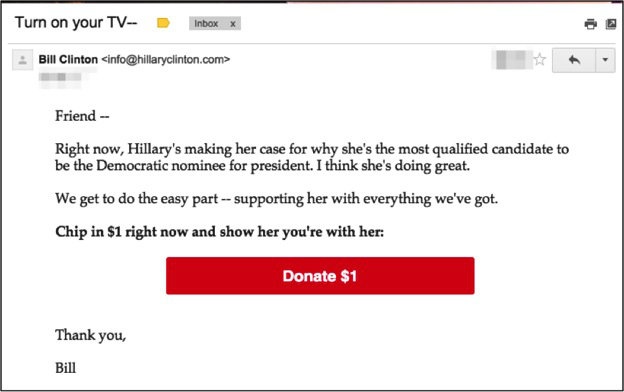
Here’s another example of a similar fundraising email campaign, but one that effectively uses a CTA button.
The other advantage in this example is the sender name. Everyone knows who Bill Clinton is, and name familiarity helps improve open rate.
Example 3: Fundraising (Bernie Sanders)
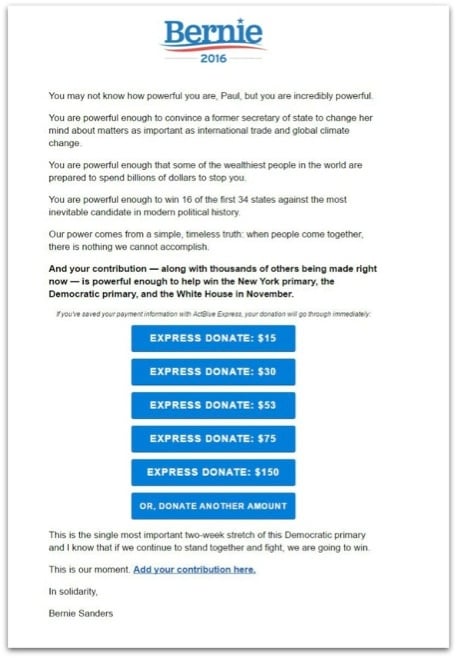
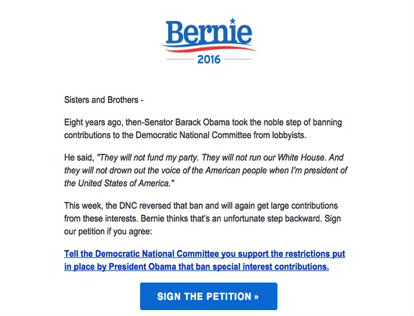
Bernie Sanders’ political email campaign strategy delivers a valuable lesson in visual consistency. Each email open is an opportunity to make another impression and improve brand recognition, which means brand consistency is key. Consistency also fosters trust, and trust wins campaigns.
Once again, these email campaigns contain short copy that represents a big message. And CTA buttons are put to excellent use.
Example 4: Fundraising (Ben Carson)
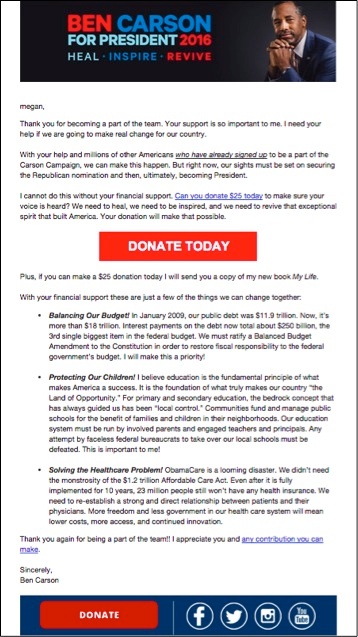
In this example, we see excellent branding and a bright, eye-catching CTA. But the big drawback is that it’s text-heavy. Email marketers must consider the attention spans of their target audiences, as well as how recipients will be viewing their messages. More email is read on mobile than on desktop.
This amount of text requires a lot of scrolling, particularly on a mobile device, and will likely result in readers losing interest, leaving the email and missing out on the message and desired action.
Example 5: Voter Appreciation (Barack Obama)
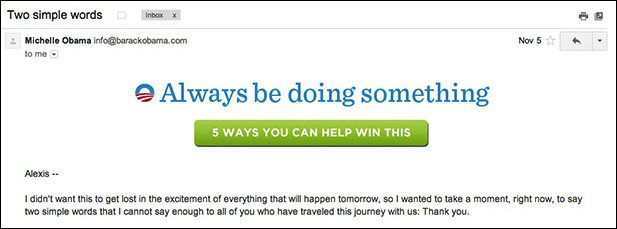
Obama’s political marketing team also ran this flawless email campaign.
Pay close attention to the subject line, “Two simple words.” It’s short and has an air of mystery, which helps boost the open rate.
The sender is Michelle Obama (another familiar name), and once more, the email is well-branded with a brief message.
What works well about this campaign is that, instead of asking for something, it’s thanking the recipient and providing them with more information (in other words, it’s providing value). The CTA button is colorful and placed at the top of the email to ensure it gets exposure, even if the recipient doesn’t read the body of the email. Plus the CTA language inspires action.
Example 6: Voter Appreciation (Mike Lee)

Here’s another example of a successful “thank you” email campaign. Unfortunately, it misses the personalization mark by greeting recipients as “Team” instead of each person’s name.
On the plus side, the CTA is likely a link asking recipients to subscribe, which is excellent practice. Because of the CAN-SPAM Act and increasingly stringent ISPs, it is always advisable to ask recipients to “opt in” to receive your messaging. Failure to do so could result in ISPs mistaking your domain as spam, which will damage your reputation, prevent you from getting your message in front of the right audience, and (as it relates to politics) could contribute to losing an election.
If done incorrectly, email marketing can annoy voters, damage a candidate’s reputation and lead to a slip in the polls. But when executed properly, email marketing campaigns can mean the difference between a win and a loss. While your email marketing might not have as much on the line as the above examples do, your campaigns are certainly still important to your brand. Take note of what these political marketers did well (and not so well) to make the most of your email marketing.
Take full advantage of email marketing for your brand by enabling personalization and better audience segmentation with Email Intelligence.
 Affiliate Marketing
Affiliate Marketing Automotive
Automotive eCommerce and Retail
eCommerce and Retail FinTech
FinTech LeadGen
LeadGen Nonprofit and Political
Nonprofit and Political Payments
Payments Technology Platforms
Technology Platforms Tourism and Hospitality
Tourism and Hospitality
 With so many communication channels at our disposal, and an unprecedented degree of
With so many communication channels at our disposal, and an unprecedented degree of 






